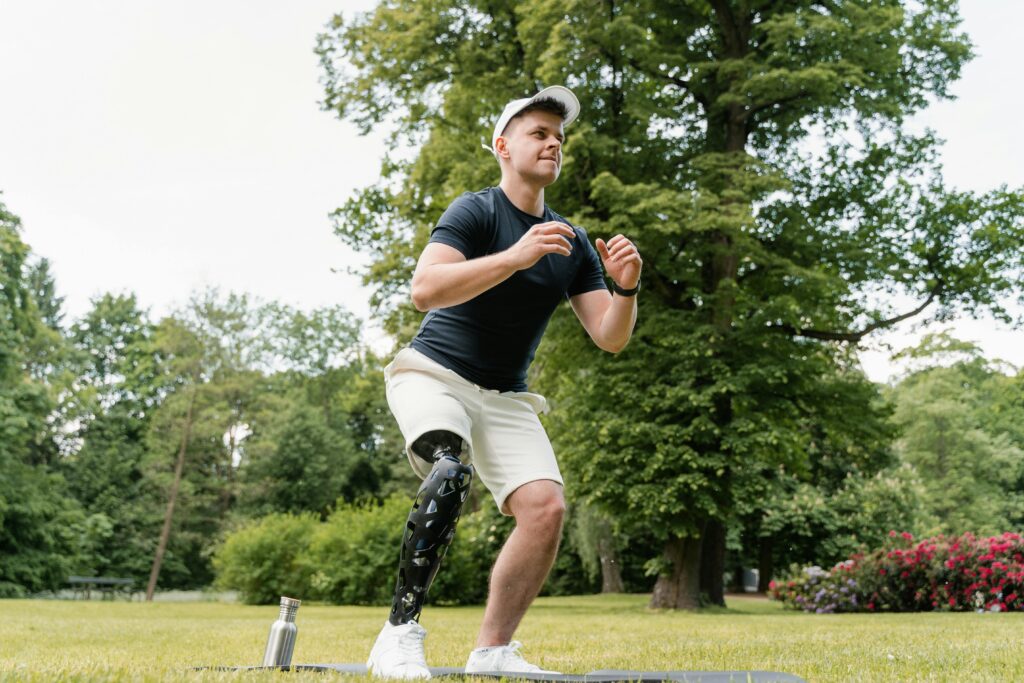Caregiving for individuals with disabilities or mobility challenges requires a set of skills, compassion, and understanding. Whether you’re caring for a family member, friend, or client, your role as a caregiver ensures their well-being, comfort, and independence. As a caregiver, you’ll face significant physical strain from tasks, such as lifting, transferring, and providing constant assistance. This can lead to musculoskeletal issues, fatigue, and heightened stress levels, impacting your overall well-being. There’s also the emotional toll of witnessing your loved one’s struggles and managing complex care needs, which can contribute to mental health challenges like anxiety, depression, and caregiver burnout.
In this comprehensive guide, we’ll explore 20 practical tips for caregivers so you can not only provide compassionate care for individuals with disabilities and mobility limitations but also yourself. From accessible caregiving techniques to empowering strategies, let’s take a look into effective ways to enhance your experience taking care of yourself and your loved ones, or clients.
Helpful Guidance and Tips for Caregivers
Prioritize Safety and Accessibility
Make sure the place where you and the person you’re caring for live is safe and easy to move around. Put up grab bars in the bathroom, ramps to make it easier to get in and out, and floors that aren’t slippery so nobody falls and gets hurt. This helps them stay independent and keeps accidents from happening.
Establish Clear Communication
When you talk openly and honestly with the person you’re looking after, it builds trust and makes it easier to understand each other. For example, if they prefer a certain way of doing things, like how they like their food prepared or how they like to be helped with dressing, listening to them and following their preferences shows that you care about their feelings and needs. Similarly, when you share your thoughts and feelings with them, it creates a supportive environment where both of you can work together to solve any problems or challenges that come up. For instance, if you’re feeling overwhelmed or need help with something, telling them about it can lead to finding solutions together, like asking other family members for assistance or adjusting schedules to make things easier for everyone.
Create a Support Network
It’s important to have people you can turn to for help and support when you need it. For example, if you need someone to watch over the person you’re caring for while you take a break, reaching out to family members or friends can give you the time you need to recharge. Additionally, having a network of healthcare professionals, like doctors or therapists, can offer valuable advice and support for both you and the person you’re caring for. They can guide you on medical issues, offer emotional support, and connect you with resources that can make caregiving easier. By building a strong support network, you’ll have a team of people who are there for you during the ups and downs of caregiving.
Educate Yourself
Taking the time to learn about the disabilities or conditions of the person you’re caring for can help you better understand their needs and how to support them. For example, if they have a physical disability that affects their mobility, learning about the specific challenges they face, such as difficulty with walking or using their hands, can help you find ways to make daily tasks easier for them. Similarly, if they have a cognitive condition like autism or Alzheimer’s disease, educating yourself about their condition can help you communicate more effectively and provide the appropriate level of support. It will make you better equipped to provide compassionate and understanding care that meets their individual needs.
Foster Independence
Encouraging the person you’re caring for to do things on their own as much as they can helps them feel more independent and capable. For instance, if they’re able to dress themselves with a little assistance, let them try and provide support only when needed. Also, involving them in decision-making, like letting them choose what they want to eat for dinner or how they want to spend their free time, gives them a sense of control over their own lives. By empowering them to take charge of their daily activities and decisions, you’re helping them maintain their dignity and self-confidence while still being there to offer support when it’s truly needed.
Adapt to Changing Needs
Being flexible and ready to change your caregiving approach as the person’s needs change is important. For example, if they develop new challenges or their condition worsens, you may need to adapt the way you assist them with daily tasks or modify their living environment to accommodate any changes. Additionally, as they progress in their recovery or treatment, you might need to adjust your caregiving techniques to support their independence and growth. You can ensure that they receive personalized and effective care that meets them where they are in their journey.
Utilize Assistive Devices
Take advantage of tools and technology that can help the person you’re caring for become more independent and improve their quality of life. If they have difficulty moving around, you might consider using mobility aids like wheelchairs or walkers to help them get around more easily. Communication devices such as speech-generating devices or text-to-speech apps can help them express themselves and communicate their needs more effectively. Explore available devices on the market so you can find solutions that address their specific challenges and empower them to live more independently.
Practice Patience and Compassion
Remember to be patient, understanding, and kind while providing care. This means being aware of the person’s emotions and challenges, and offering comfort and encouragement when things get tough. If they’re feeling frustrated or upset, take the time to listen to their concerns and provide reassurance that you’re there to help. Show empathy by putting yourself in their shoes can help strengthen your bond and make them feel understood and supported. A nurturing and supportive environment promotes their well-being and fosters trust in your caregiving relationship.
Seek Professional Help
Don’t be afraid to reach out for help from healthcare professionals, therapists, or support groups when you need it. These resources offer valuable guidance and assistance in navigating the complex challenges of caregiving. Whether it’s seeking advice on medical issues, finding emotional support, or connecting with others who understand your experiences, reaching out for professional help can provide you with the support and resources you need to effectively care for your loved one and yourself.

Promote Physical Activity
Encourage the person you’re caring for to participate in regular physical activity to keep their body moving and maintain their overall health. Tailor exercises to fit their abilities and interests, ensuring they enjoy the experience. Making physical activity enjoyable can help them stay motivated and improve their mobility and well-being over time.
Maintain a Routine
Creating a daily routine is one of the essential tips for caregivers. A routine offers stability and predictability for individuals with disabilities. Maintaining a consistent schedule for meals, medication, and activities helps them feel secure and empowered. Stick to a routine so you can provide a sense of control and organization, which can enhance their overall well-being and quality of life.
Foster Social Connections
Combat social isolation by actively supporting the person you’re caring for to engage in social interactions and connect with others. Plan outings, encourage visits with friends and family, or facilitate participation in community events to foster social engagement. By promoting social interactions and connections, you help them feel included, valued, and connected to their community, which contributes to their overall happiness and well-being.
Practice Self-Care
Make sure to take care of yourself too by practicing self-care regularly. This means setting aside time for things that make you happy and relaxed, like reading a book, going for a walk, or indulging in a hobby. It also involves reaching out to friends and family for support and help when you need it, whether it’s for a listening ear or assistance with caregiving tasks. Remember, taking care of yourself is just as important as taking care of the person you’re looking after, and it allows you to be the best caregiver you can be.
Advocate for Accessibility
Be a strong advocate for accessibility and inclusion in your community by speaking up about the importance of having facilities, transportation, and services that are accessible to everyone. For instance, you can advocate for wheelchair ramps in public buildings, accessible transportation options, and accommodations for individuals with disabilities in public events and activities. Raising awareness and advocating for change helps create a more inclusive and welcoming environment where individuals with disabilities can fully participate and thrive.
Stay Organized
Keep detailed records of medications, appointments, and important information related to the person’s care. Using tools like calendars, medication trackers, or digital apps can help you stay organized and avoid missing appointments or doses. This ensures that the person receives the care they need on time and helps you keep track of important information to provide the best possible support.
Be Mindful of Burnout
One of the most important tips for caregivers is to recognize the signs of burnout, such as fatigue, irritability, and feelings of overwhelm. Take breaks when needed, and prioritize self-care to prevent burnout and maintain your well-being. It’s important to listen to your body and mind and to seek support when you start feeling overwhelmed.
Practice Active Listening
Listen carefully to the concerns and needs of the person you’re caring for. Validate their feelings and experiences, and collaborate with them to find solutions to any challenges that come up. By actively listening and acknowledging their perspective, you foster a sense of trust and mutual respect in your caregiving relationship.
Celebrate Achievements
Acknowledge and celebrate the achievements of the person you’re caring for, no matter how small. Positive reinforcement can boost their confidence and motivation, and strengthen the bond between you as a caregiver and the care recipient. Recognizing their efforts and accomplishments shows that you value and appreciate their progress.
Stay Informed
Stay informed about the latest developments in disability rights, healthcare, and assistive technology. By staying connected with advocacy organizations and support groups, you can access valuable resources and information. For example, joining a support group for caregivers of individuals with disabilities can provide insights into new caregiving techniques or available community resources. Similarly, staying up-to-date with advancements in assistive technology can help you explore new tools and resources that may improve the quality of life for the person you’re caring for.
Take Pride in Your Role
Finally, take pride in the important role you play as a caregiver. Your dedication, compassion, and support make a significant difference in the lives of individuals with disabilities and mobility challenges. Remember to prioritize self-care and seek support when needed, as caring for others starts with caring for yourself.
Taking Care of Yourself and Your Loved Ones
Throughout this guide, we’ve explored 20 practical tips for caregivers aimed at providing compassionate care for individuals with disabilities while also prioritizing self-care. From prioritizing safety and accessibility to fostering social connections and advocating for accessibility, each tip serves as a valuable tool in enhancing your caregiving experience.
Remember that it’s essential to take pride in the vital role you play. Your dedication, compassion, and support make a significant difference in the lives of those you care for. However, it’s equally important to prioritize self-care and seek support when needed. By caring for yourself, you can ensure that you have the energy, resilience, and compassion to continue providing high-quality care to your loved ones or clients.
Featured image by Georg Arthur Pflueger on Unsplash.


